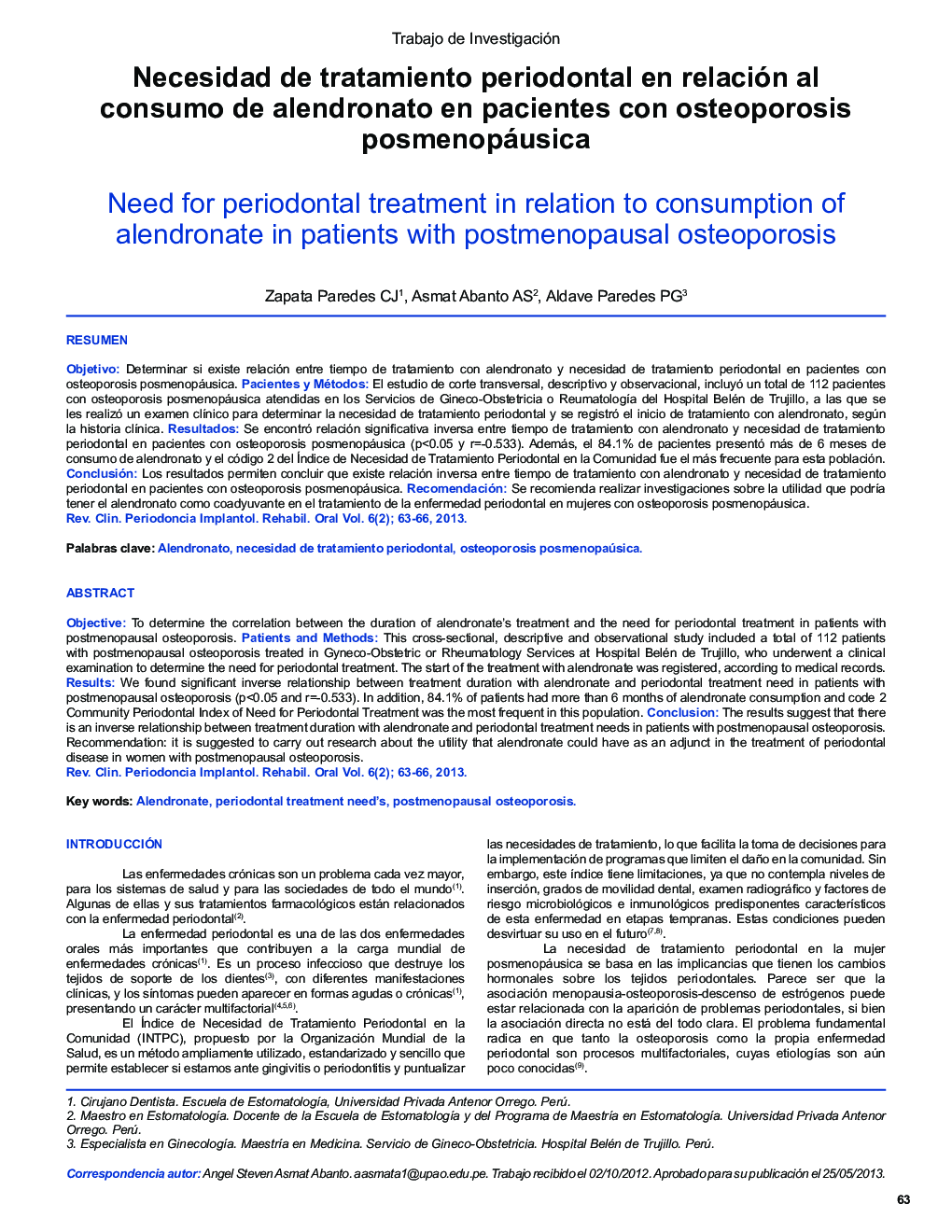| Article ID | Journal | Published Year | Pages | File Type |
|---|---|---|---|---|
| 3172511 | Revista Clínica de Periodoncia, Implantología y Rehabilitación Oral | 2013 | 4 Pages |
ResumenObjetivoDeterminar si existe relación entre tiempo de tratamiento con alendronato y necesidad de tratamiento periodontal en pacientes con osteoporosis posmenopáusica.Pacientes y MétodosEl estudio de corte transversal, descriptivo y observacional, incluyó un total de 112 pacientes con osteoporosis posmenopáusica atendidas en los Servicios de Gineco-Obstetricia o Reumatología del Hospital Belén de Trujillo, a las que se les realizó un examen clínico para determinar la necesidad de tratamiento periodontal y se registró el inicio de tratamiento con alendronato, según la historia clínica.ResultadosSe encontró relación significativa inversa entre tiempo de tratamiento con alendronato y necesidad de tratamiento periodontal en pacientes con osteoporosis posmenopáusica (p<0.05 y r=-0.533). Además, el 84.1% de pacientes presentó más de 6 meses de consumo de alendronato y el código 2 del Índice de Necesidad de Tratamiento Periodontal en la Comunidad fue el más frecuente para esta población.ConclusiónLos resultados permiten concluir que existe relación inversa entre tiempo de tratamiento con alendronato y necesidad de tratamiento periodontal en pacientes con osteoporosis posmenopáusica.RecomendaciónSe recomienda realizar investigaciones sobre la utilidad que podría tener el alendronato como coadyuvante en el tratamiento de la enfermedad periodontal en mujeres con osteoporosis posmenopáusica.
ObjectiveTo determine the correlation between the duration of alendronate's treatment and the need for periodontal treatment in patients with postmenopausal osteoporosis.Patients and MethodsThis cross-sectional, descriptive and observational study included a total of 112 patients with postmenopausal osteoporosis treated in Gyneco-Obstetric or Rheumatology Services at Hospital Belén de Trujillo, who underwent a clinical examination to determine the need for periodontal treatment. The start of the treatment with alendronate was registered, according to medical records.ResultsWe found significant inverse relationship between treatment duration with alendronate and periodontal treatment need in patients with postmenopausal osteoporosis (p<0.05 and r=-0.533). In addition, 84.1% of patients had more than 6 months of alendronate consumption and code 2 Community Periodontal Index of Need for Periodontal Treatment was the most frequent in this population.ConclusionThe results suggest that there is an inverse relationship between treatment duration with alendronate and periodontal treatment needs in patients with postmenopausal osteoporosis.Recommendationit is suggested to carry out research about the utility that alendronate could have as an adjunct in the treatment of periodontal disease in women with postmenopausal osteoporosis.
